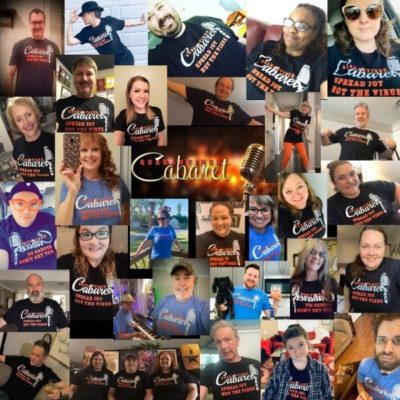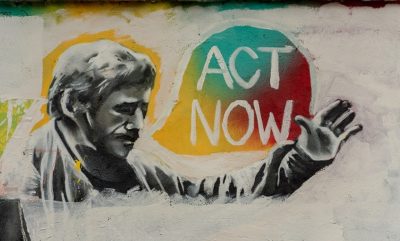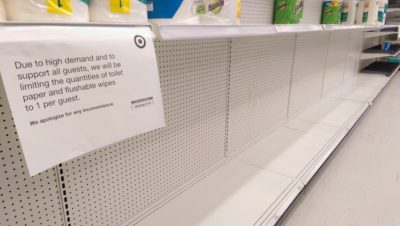by Christina Leimer | As the World Changes

Source: The Quarantined Cabaret
When COVID-19 shut the world down in early 2020, much of it went online. For people with internet access and the ability to pay for home delivery, it’s been a way to keep basic needs met and help some small businesses survive—even if it’s been rocky.
What I’ve found hopeful is the creative ways individuals, families and communities are adapting to meet emotional needs as well.
Windows and Balconies
For seniors suddenly isolated in nursing homes and families unable to visit, windows became a bright spot. One man whose job involved driving a bucket truck drove it to his mother’s third floor window at her assisted living facility. He phoned her and when she opened the curtains, there he was, smiling and waving. Windows became places where engagements were announced and tic-tac-toe and hangman were played with grandkids. Teddy bears on window sills were the focus of community scavenger hunts to entertain and connect at a distance. Some stepped outside their windows, turning their balconies into stages, letting neighborhoods sing and dance.
Sharing & Enjoying Talent
The Quarantined Cabaret popped up on Facebook to give singers, dancers, actors, comedians and other creative performers a way to share their talents and people stuck at home a way to enjoy them. Then it morphed to sharing high school productions that were cancelled due to the shelter-in-place. What started as a small group of friends quickly turned into tens of thousands of people from all 50 states and many countries. People who don’t usually get to showcase their talents and people who live in remote areas where it’s difficult to find live entertainment benefit too.
Re-Purposing & Making Do
One couple let their elementary school aged kids organize date nights for them. Travel professionals, missing life on the road and using their gear, re-purposed it to help neighbors haul their groceries, set up camp for their kids in the living room or create a swinging hammock bed for the feel of adventure at home. Some people dressed in head-to-toe costumes or outfitted themselves in clear-plastic trash bags to hug loved ones.
Adapting Business and Ritual
Some small distilleries switched from brews to making hand sanitizer. Others re-tooled to sew and distribute masks. Restaurants, closed to indoor dining and shut down completely in some places, switched to home delivery and providing free-of-charge meals to community members in need. With traditional funeral and memorial rites curtailed, funeral directors and faith leaders modified rites, such as drive-in funeral ceremonies and livestreaming services. Newspapers expanded online obituaries. Some families held funerals at home.
Attention Affects Behavior
What captures our attention shapes our sense of the world. When what we hear about most in the media are the problems, it can be overwhelming. Especially at a time when we’re so much more isolated than usual. Let’s notice our adapting, resilience and creativity and give it its due. By all public health accounts, the pandemic’s going to be with us quite awhile longer. In our global world, it won’t be the last either. One important change that could come from this COVID experience would be a more balanced portrayal of our lives and world.
Subscribe
Christina Leimer, aka The Intuitive Sociologist
by Christina Leimer | As the World Changes
I’m starting to see articles speculating on what might change as a result of the coronavirus pandemic. Some note that the changes following the 9/11 terrorist attack in NYC and the 2008 financial crash weren’t particularly positive. They didn’t change the trajectory the U.S. was already on. After 9/11, there was heightened monitoring of movement through airports, increased surveillance of citizens and long-term war. With the 2008 financial fallout, there were corporate bailouts with few financial controls and plenty of personal bankruptcies that tightened lending to individuals and made them renters instead of homeowners.
The same thing will happen with this pandemic if we act from the same basic underlying assumptions, or logics, of mainstream American culture.
Ways to Think About Cul

Source: Creative Commons
ture
There are many ways to describe culture and I’m going to take a few liberties with two models to make my point in this post.
A Management Science View of Culture
Emeritus MIT Management professor Edgar Schein’s model for organizational culture is fairly straightforward and can apply to societies. Schein describes 3 levels of culture based on the extent to which you can see it. The surface level is artifacts and behaviors—symbols like the flag, for example, the constitution, laws, policies, the ways we build cities, the transportation we use, and the processes for how we get things done.

Photo Courtesy of Creative Commons
The next level is espoused values—what we say we believe and the rules and norms we say we follow. It’s who we say we are, for example American grit or the land of opportunity, or compassionate and caring.
Below the surface is where things matter a lot—those deep, tacit beliefs drive our behavior and decision making. They’re so solid, so engrained, we rarely if ever question them. They give us certainty about the world and the assurance that we know how to navigate it. That profit motivates innovation, for example, or that individuals should pull themselves up by their own bootstraps, or family is the most important, or I have the right to defend myself.
A Shamanic View of Culture
Shamans too look at layers of human life—which includes culture. According to shaman Jon Rasmussen, there’s 4 layers—the literal, meaning the material world, including our bodies and the systems we create and products we build. That’s the surface. The psycho-spiritual/mind is something akin to the espoused beliefs, It’s how we process information, perceive and make meaning. While shamans, like organizational change managers, must work at all levels to create substantial, lasting change, it’s the two deepest levels where the most powerful work can be done.
Without change at the mythic and essential energy levels, the surface level changes won’t hold. The mythic is the images, stories and symbols that influence us usually without conscious recognition. It’s similar to Jung’s collective archetypes. We typically tap into it through ritual, art, music or dance. The essential energy layer is the soul. It’s where the blueprint lies for what we see on the other layers. Not only are the energetic and the mythic typically unquestioned and taken-for-granted, the energetic layer isn’t even part of secular mainstream Western culture. How we can access this layer for systems and culture change is a key question I have. But it’s a digression at the moment.
Intentional Change Takes Intentional Questioning
The point is, if we don’t unearth and intentionally question basic assumptions motivating our society and how we live, even if something changes after the pandemic, it’ll just be a different version of what we already have. There will be no fundamental change. The same, or worse, problems will recur at some point.
But, this kind of questioning creates huge anxiety and fear. Because we need the certainty of our taken-for-granted world to feel secure. That’s at least part of why presidential candidate Senator Bernie Sanders draws such heat. He’s pointing out the destructive parts of the way we’ve organized society and proposing new ways as a remedy. Those new ways rest on very different assumptions about how the world should be and our place in it.
So, what will change following the post-COVID19 pandemic? Surely, there will be tweaks. I think major change depends on whether we’re willing to honestly question what worked, what didn’t, why and related cultural assumptions while mitigating the fear and anxiety doing so causes. Then we can intentionally consider whether it’s time to re-make our world and how we might do it.
Subscribe
Christina Leimer, aka The Intuitive Sociologist
by Christina Leimer | As the World Changes
Today I’m thinking about the responses I see to the corona virus #stayathomechallenge #shelterinplace #lockdown. Someone on Twitter asked, will this pandemic make us better, worse or not change us at all.
The way I see the world, how we come out of this depends on what lessons we learn and whether we use them to change our social systems and culture.
The changes after the September 11 terrorist attacks led us into a series of seemingly unending wars, searches & restrictions at airports, and more surveillance of citizens. The 2008 financial crisis resulted in far more renters than homeowners after bankruptcies, more extreme inequality and political polarization. It doesn’t seem that our fundamental ways of life changed for the better with either of these crises.

Photo by Rod Long at Unsplash
During this corona virus crisis, I see many people stepping up, offering assistance to others. Some are paying contract workers to help them make it through, checking up on elderly and ill neighbors, making trips to the grocery store or drug store for people who are more at risk, even collecting or making masks and ventilator parts to help hospitals running short on these necessary supplies.
At the same time, I see some people hoarding, price gouging, buying guns, fighting and ignoring social distancing orders—even flaunting their willingness to expose others to a potentially lethal virus.
Most of us are probably just doing our best to comply with public health advice to protect ourselves and others. But human nature is always going to have this mix—both within us and among us. The balance lies in what our culture expects and allows.
Altruism, compassion and the desire to do something meaningful, something that’s greater than ourselves are as much a part of human nature as fear, anger, greed and self-centeredness. But American culture highlights the latter. The news dwells on it, and it’s what much of our entertainment is based on. On any news day, it’s murder, bombings, hate, deception, child abuse, all the human depravity. Sure, we need to know about threats. It helps us survive. But when that’s all there is, and when crime, violence and brutality are the basis of entertainment, we’ve gone way beyond the need to know for survival. In many shows, movies, and games the violence is gratuitous and extreme. Then there’s the greed. The main character in the 1987 movie Wall Street proclaiming “greed is good” became an American mantra along with Ayn Rand’s philosophy of maximizing your own happiness and goals. These characteristics are strong enough in American culture that altruism, compassion and inspiration are often viewed as sentimental, ineffectual or weak.
Artists, musicians, writers, photographers, filmmakers, journalists, producers and agents, you create our cultural stories and the images that tell us who we are and show us our capabilities and possibilities. You produce the food for our spirit. Stories need tension, but physical conflict is a lazy default. Why not draw out the drama, the sacrifice, the personal and moral dilemmas and decisions to do the right thing—especially when it contradicts cultural expectations? Why not show us the complexity and complications of life? Why not dream?
For the rest of us, we either support or undermine these characteristics of our culture through the choices we make. It’s our power. What shows do you watch? What books do you buy? What music do you listen to? What do you share on social media? What do you talk about?
Maybe we’re in a turnaround phase on this one. Last year, one of the most successful films was A Beautiful Day in the Neighborhood. I see a lot of social media praise for people like Ambassador Marie Yovanovitch, David Holmes and Colonel Vindman, people who told the truth in the face of pressure to keep quiet. I’m seeing many thank you messages to store clerks, healthcare workers, police and firefighters and others who are keeping the infrastructure that supports our basic needs running while the rest of us are told to stay home to minimize the pandemic.
Already, the U.S. president is getting antsy, wanting people to go back to work to make sure the economy keeps humming along. Real change takes time, time for reflection, time to adjust. But it can happen in an instant when the time is right. When the old way has worn itself out. If we no longer prop it up, a new way can come to life.
Subscribe
Christina Leimer, aka The Intuitive Sociologist
by Christina Leimer | As the World Changes

Stores limit purchases after toilet paper supplies sell out due to hoarding at start of corona virus scare. Photo by Christina Leimer
Whether for individuals, families, communities or whole societies, change is most likely when there’s a crisis. That’s now. With global travel nearly none, large social events cancelled, schools and non-essential businesses shuttered so people can #ShelterInPlace, the coronavirus lockdown is giving us ample time to think about how we do what we do and why we do it that way. We have time to notice the effects and question taken-for-granted assumptions. Americans don’t typically reflect at the societal level. So, what if we did?
The huge disrupters are 1) a global pandemic, and to try to stop its spread, 2) social distancing. We can’t know how long the #stayathomechallenge will last. Many scientists are working to develop a vaccine—but even when they do, there will be other global disease outbreaks. What can we learn and change that will help us prevent disease spread in the future and handle it when prevention fails?
A few things I question:
Global Travel: Yes, it’s interesting and informative and helps us realize we’re all connected. But how much of it do we really need? For business, how much of it is a perk or status-driven? With easy videoconferencing access, why not use this technology most of the time instead of in-person travel?
Global travel isn’t likely to stop forever, so what could change given the reality of pandemics? Over time, airlines have been packing us in closer and closer together, smaller seats, less leg room, longer wait times in airport terminals and on tarmacs. Are there ways to spread us out? Ventilate the cabin? What’s up with air traffic control that we’re sitting on the runway for an hour or more? What about airplane design? I’ve often wondered why everyone must enter and exit through a single door instead of using the side and rear doors of the plane too.
Staying Home: Despite American individualist culture, it’s also highly social. Most people spend a lot of time with others. As a society, we’re busy, busy, busy. Being so busy might be why home delivery services have been increasing already. Even high-end restaurant food can now be delivered. With restaurants in several States ordered to close except for take-out, might this be a change that sticks around? Will there be fewer sit-down restaurants? Or fewer tables farther apart, accommodating less customers? Many restaurants already operate on a thin profit margin and it’s a high failure rate business. Maybe it’s an industry ripe for change.
Sick Leave and Healthcare Coverage: Making sure all Americans can get healthcare is an ongoing political battle. Many employers don’t provide paid sick leave either. That too has been a political fight with little traction. In the scramble to halt a pandemic, lack of sick leave and no health insurance is a deadly combination. Congress just passed the Families First Act. That bill offers some paid leave to employees of companies with fewer than 500 employees with potential exemption for smaller companies. Also, it requires anyone seeking testing or treatment for coronavirus to be treated at no cost to them. But, the bill is only funded through September of this year—the end of the fiscal year and is slated to end with the 2020 calendar year. Will paid sick leave become a standard practice? Will all Americans get access to low-cost healthcare in general after this crisis passes?
Insufficient Hospitals and Medical Supplies: With about 6,000 hospitals and 900,000 beds in the U.S. (American Hospital Association), a pandemic can quickly outstrip capacity. Over the last couple of decades many hospitals have closed due to changes in the healthcare industry and cost. Many rural areas have little or no healthcare providers or facilities. Infrastructure in general, schools, roads, utilities, has been minimally maintained. Will this crisis prompt review and updating of physical infrastructure? More telemedicine?
Schools: Why keep the agrarian-originated summer-off schedule? Yes, I know for teachers it’s become a perk to have 3 months off. Families have accommodated and travel during summer. But, school could be year round with break times staggered. Teachers could take breaks at different times. Instead of crowding vacations into a single season, spread them out. And while we’re questioning, what about the day-to-day scheduling. I know some parents work nights and weekends and all kinds of hours, but most business happens during the day. Why not schedule school hours to coincide with most people’s work day?
Cities: This is a question I’ve been wondering about for a while, why are we piling up in cities? And in a relatively few major cities? Given the technology we have for communication, for delivery, for manufacturing and printing, why aren’t we living in more, smaller cities and towns?
The questions we might ask are unlimited. My point for this post is just to take advantage of this crisis time to get us thinking and imagining how our social institutions and the ways we live might be different, and better for us. What questions are you asking?
Subscribe
Christina Leimer, aka The Intuitive Sociologist
by Christina Leimer | As the World Changes
The corona virus pandemic is a prime time to make systemic and cultural changes. Suddenly, we’re forced to stop doing things we do rotely, like shaking hands when meeting others. It’s so familiar, and so expected, #NoHandShake creates some awkward and funny moments—like elbow bump or flashing the Vulcan greeting. When Prince Charles forgot, he backed away then used the Namaste hands together greeting.

Photo Source: ETOnline Prince Charles Hilariously Forgets the NO HANDSHAKE POLICY Amid Health Concerns
When gaps appear between the usual practice and changed circumstance, as they often do in crisis or stress, that’s when new ways can be injected. For the new practice to stick, it has to convey a similar meaning as the old way unless the meaning itself is open to change too. So in the case of the handshake, replacing it with an elbow bump won’t work. Not serious enough. The Vulcan handshake carries an otherworldly feel given its origin in Star Wars, so that won’t take hold widely.
Interesting that Prince Charles resorted to Namaste, a traditional Hindu greeting. Probably due to Britain’s historical relationship with India, it’s a familiar gesture to him. It’s a respectful and widely enough recognized gesture that it could become the new global way. Diffusion—practices from one culture moving into another— is a common way cultures change. If the Namaste gesture does take hold, it will alleviate touching which some cultures avoid in public settings and which makes some individuals uncomfortable. What about a slight bow or just a smile?
The #NoHandShake is a small example of when and how change can happen. It’s a change you can make. Just choose your greeting gesture and use it. Eventually, either a handshake will return once the pandemic threat is past, or the new way will become the standard greeting. Pandemics are going to occur periodically in our global society, so why not make a no-touch greeting standard practice.
Larger system and culture change can happen in times of crisis too, so watch for the gaps. Then, try doing something differently in that space between the old way and the new need. The change might catch hold.
Subscribe
Christina Leimer, aka The Intuitive Sociologist






